Fang Zhang
AgentSociety: Large-Scale Simulation of LLM-Driven Generative Agents Advances Understanding of Human Behaviors and Society
Feb 12, 2025Abstract:Understanding human behavior and society is a central focus in social sciences, with the rise of generative social science marking a significant paradigmatic shift. By leveraging bottom-up simulations, it replaces costly and logistically challenging traditional experiments with scalable, replicable, and systematic computational approaches for studying complex social dynamics. Recent advances in large language models (LLMs) have further transformed this research paradigm, enabling the creation of human-like generative social agents and realistic simulacra of society. In this paper, we propose AgentSociety, a large-scale social simulator that integrates LLM-driven agents, a realistic societal environment, and a powerful large-scale simulation engine. Based on the proposed simulator, we generate social lives for over 10k agents, simulating their 5 million interactions both among agents and between agents and their environment. Furthermore, we explore the potential of AgentSociety as a testbed for computational social experiments, focusing on four key social issues: polarization, the spread of inflammatory messages, the effects of universal basic income policies, and the impact of external shocks such as hurricanes. These four issues serve as valuable cases for assessing AgentSociety's support for typical research methods -- such as surveys, interviews, and interventions -- as well as for investigating the patterns, causes, and underlying mechanisms of social issues. The alignment between AgentSociety's outcomes and real-world experimental results not only demonstrates its ability to capture human behaviors and their underlying mechanisms, but also underscores its potential as an important platform for social scientists and policymakers.
Deep Learning based Quasi-consciousness Training for Robot Intelligent Model
Jan 31, 2025



Abstract:This paper explores a deep learning based robot intelligent model that renders robots learn and reason for complex tasks. First, by constructing a network of environmental factor matrix to stimulate the learning process of the robot intelligent model, the model parameters must be subjected to coarse & fine tuning to optimize the loss function for minimizing the loss score, meanwhile robot intelligent model can fuse all previously known concepts together to represent things never experienced before, which need robot intelligent model can be generalized extensively. Secondly, in order to progressively develop a robot intelligent model with primary consciousness, every robot must be subjected to at least 1~3 years of special school for training anthropomorphic behaviour patterns to understand and process complex environmental information and make rational decisions. This work explores and delivers the potential application of deep learning-based quasi-consciousness training in the field of robot intelligent model.
A real-time battle situation intelligent awareness system based on Meta-learning & RNN
Jan 23, 2025



Abstract:In modern warfare, real-time and accurate battle situation analysis is crucial for making strategic and tactical decisions. The proposed real-time battle situation intelligent awareness system (BSIAS) aims at meta-learning analysis and stepwise RNN (recurrent neural network) modeling, where the former carries out the basic processing and analysis of battlefield data, which includes multi-steps such as data cleansing, data fusion, data mining and continuously updates, and the latter optimizes the battlefield modeling by stepwise capturing the temporal dependencies of data set. BSIAS can predict the possible movement from any side of the fence and attack routes by taking a simulated battle as an example, which can be an intelligent support platform for commanders to make scientific decisions during wartime. This work delivers the potential application of integrated BSIAS in the field of battlefield command & analysis engineering.
An Instance-based Plus Ensemble Learning Method for Classification of Scientific Papers
Sep 21, 2024
Abstract:The exponential growth of scientific publications in recent years has posed a significant challenge in effective and efficient categorization. This paper introduces a novel approach that combines instance-based learning and ensemble learning techniques for classifying scientific papers into relevant research fields. Working with a classification system with a group of research fields, first a number of typical seed papers are allocated to each of the fields manually. Then for each paper that needs to be classified, we compare it with all the seed papers in every field. Contents and citations are considered separately. An ensemble-based method is then employed to make the final decision. Experimenting with the datasets from DBLP, our experimental results demonstrate that the proposed classification method is effective and efficient in categorizing papers into various research areas. We also find that both content and citation features are useful for the classification of scientific papers.
Difformer: Empowering Diffusion Model on Embedding Space for Text Generation
Dec 19, 2022



Abstract:Diffusion models have achieved state-of-the-art synthesis quality on visual and audio tasks, and recent works adapt them to textual data by diffusing on the embedding space. But the difference between the continuous data space and the embedding space raises challenges to the diffusion model, which have not been carefully explored. In this paper, we conduct systematic studies and analyze the challenges threefold. Firstly, the data distribution is learnable for embeddings, which may lead to the collapse of the loss function. Secondly, as the norm of embedding varies between popular and rare words, adding the same noise scale will lead to sub-optimal results. In addition, we find that noises sampled from a standard Gaussian distribution may distract the diffusion process. To solve the above challenges, we propose Difformer, a denoising diffusion probabilistic model based on Transformer, which consists of three techniques including utilizing an anchor loss function, a layer normalization module for embeddings, and a norm factor to the Gaussian noise. All techniques are complementary to each other and critical to boosting the model performance together. Experiments are conducted on benchmark datasets over two seminal text generation tasks including machine translation and text summarization. The results show that Difformer significantly outperforms the embedding diffusion baselines, while achieving competitive results with strong autoregressive baselines.
Fast Top-k Area Topics Extraction with Knowledge Base
Dec 04, 2017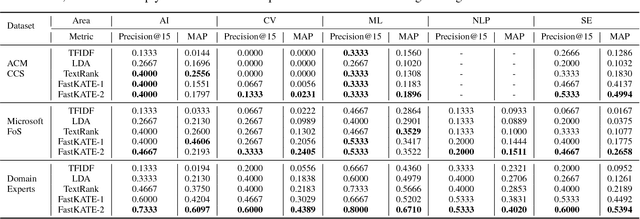
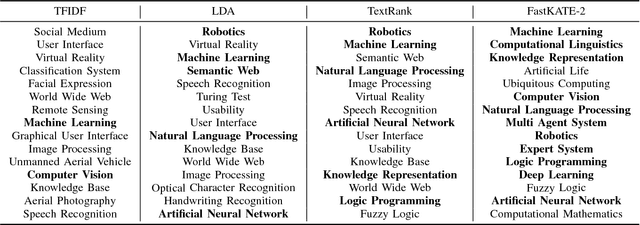

Abstract:What are the most popular research topics in Artificial Intelligence (AI)? We formulate the problem as extracting top-$k$ topics that can best represent a given area with the help of knowledge base. We theoretically prove that the problem is NP-hard and propose an optimization model, FastKATE, to address this problem by combining both explicit and latent representations for each topic. We leverage a large-scale knowledge base (Wikipedia) to generate topic embeddings using neural networks and use this kind of representations to help capture the representativeness of topics for given areas. We develop a fast heuristic algorithm to efficiently solve the problem with a provable error bound. We evaluate the proposed model on three real-world datasets. Experimental results demonstrate our model's effectiveness, robustness, real-timeness (return results in $<1$s), and its superiority over several alternative methods.
Combining Deep Reinforcement Learning and Safety Based Control for Autonomous Driving
Dec 01, 2016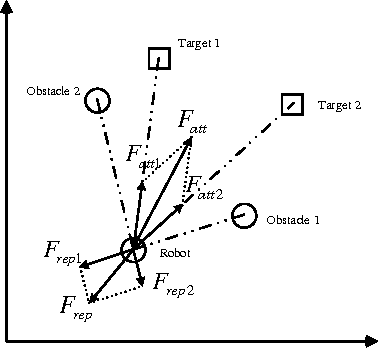
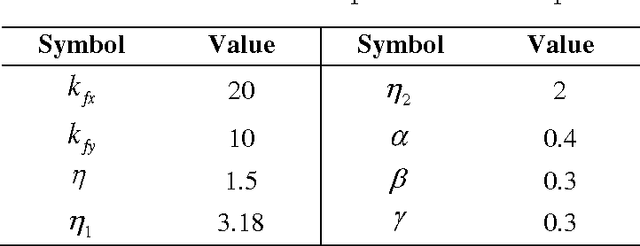
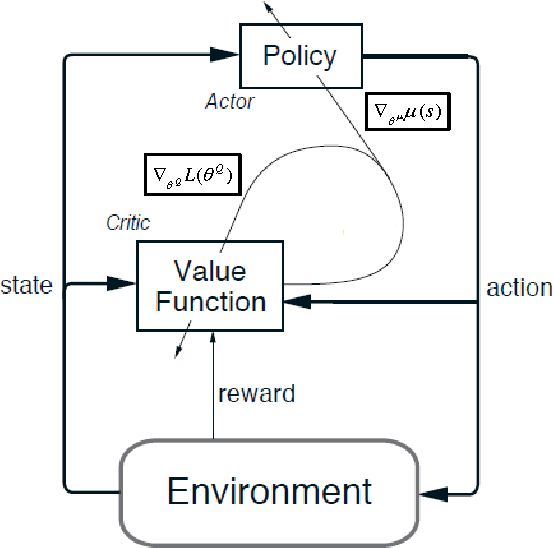
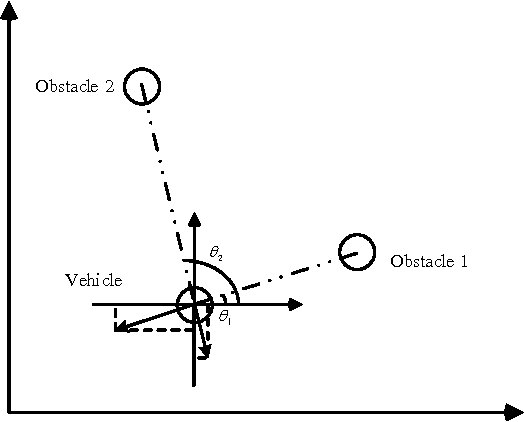
Abstract:With the development of state-of-art deep reinforcement learning, we can efficiently tackle continuous control problems. But the deep reinforcement learning method for continuous control is based on historical data, which would make unpredicted decisions in unfamiliar scenarios. Combining deep reinforcement learning and safety based control can get good performance for self-driving and collision avoidance. In this passage, we use the Deep Deterministic Policy Gradient algorithm to implement autonomous driving without vehicles around. The vehicle can learn the driving policy in a stable and familiar environment, which is efficient and reliable. Then we use the artificial potential field to design collision avoidance algorithm with vehicles around. The path tracking method is also taken into consideration. The combination of deep reinforcement learning and safety based control performs well in most scenarios.
 Add to Chrome
Add to Chrome Add to Firefox
Add to Firefox Add to Edge
Add to Edge